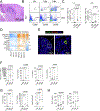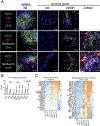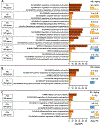Ectopic lymphoid structures in the aged lacrimal glands
- PMID: 36740002
- PMCID: PMC10323865
- DOI: 10.1016/j.clim.2023.109251
Ectopic lymphoid structures in the aged lacrimal glands
Abstract
Aging is a complex biological process in which many organs are pathologically affected. We previously reported that aged C57BL/6J had increased lacrimal gland (LG) lymphoid infiltrates that suggest ectopic lymphoid structures. However, these ectopic lymphoid structures have not been fully investigated. Using C57BL/6J mice of different ages, we analyzed the transcriptome of aged murine LGs and characterized the B and T cell populations. Age-related changes in the LG include increased differentially expressed genes associated with B and T cell activation, germinal center formation, and infiltration by marginal zone-like B cells. We also identified an age-related increase in B1+ cells and CD19+B220+ cells. B220+CD19+ cells were GL7+ (germinal center-like) and marginal zone-like and progressively increased with age. There was an upregulation of transcripts related to T follicular helper cells, and the number of these cells also increased as mice aged. Compared to a mouse model of Sjögren syndrome, aged LGs have similar transcriptome responses but also unique ones. And lastly, the ectopic lymphoid structures in aged LGs are not exclusive to a specific mouse background as aged diverse outbred mice also have immune infiltration. Altogether, this study identifies a profound change in the immune landscape of aged LGs where B cells become predominant. Further studies are necessary to investigate the specific function of these B cells during the aged LGs.
Keywords: Aging; B cells; Dry eye; Ectopic lymphoid structures; Lacrimal gland; Tertiary lymphoid organs.
Copyright © 2023 The Authors. Published by Elsevier Inc. All rights reserved.
Conflict of interest statement
Declaration of Competing Interest CSDP was a consultant to Spring Discovery from May to August 2022. All other authors declare no conflicts of interest.
Figures









References
-
- Knop E, Knop N: Lacrimal drainage-associated lymphoid tissue (LDALT): a part of the human mucosal immune system. Invest Ophthalmol Vis Sci 2001, 42:566–74. - PubMed
-
- Saitoh-Inagawa W, Hiroi T, Yanagita M, Iijima H, Uchio E, Ohno S, Aoki K, Kiyono H: Unique characteristics of lacrimal glands as a part of mucosal immune network: high frequency of IgA-committed B-1 cells and NK1.1+ alphabeta T cells. Invest OphthalmolVisSci 2000, 41:138–44. - PubMed
-
- Gudmundsson OG, Benediktsson H, Olafsdottir K: T-lymphocyte subsets in the human lacrimal gland. Acta ophthalmologica 1988, 66:19–23. - PubMed
-
- Gudmundsson OG, Bjornsson J, Olafsdottir K, Bloch KJ, Allansmith MR, Sullivan DA: T cell populations in the lacrimal gland during aging. Acta ophthalmologica 1988, 66:490–7. - PubMed
Publication types
MeSH terms
Grants and funding
LinkOut - more resources
Full Text Sources
Medical
Molecular Biology Databases
Research Materials

